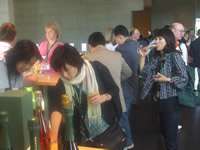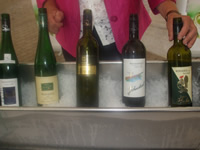 |
| Willi & his Gang with Zahel |
People in Austria have been enjoying wines for centuries and yet they are one of the newest countries to put the Appellation laws in place, among many other steps being taken recently, since they have been drinking three fourths of their production, with 70% of the exports going to the neighbouring Germany and Switzerland..
Austria is different
Although Austria produces 250million liters of wine, which is hardly 1% of total wine produced globally, it has an unusual position due to the complicated labels, low volumes, varying vintages and limited big brands. Producers have limited budgets and lack of marketing infrastructure.
But the wines produced are authentic, artisanal, family-produced, individualistic styles and natural as compared to many other nations, especially the new world, where they tend to be commercial, industrialized, big-corporate run, uniform styled (‘coca-colised’) and technical.
The Austrians are very sustainability conscious with 16% of the total plantings being organic. 75% of the farmers are part of the Integrated Production (IP) programme. One of the world’s oldest wine schools was founded in 1860, in Klosterneuburg in Austria.
Although Austria is known for excellent dessert wines- including the eiswein, staw wine and that made from Botrytised grapes, as also the dry to very sweet Grüner Veltliners, it produces excellent Rieslings, more fleshy and minerally than its counterparts in Germany. The wines are generally low in alcohol, with 11.5-13% being more of a norm. In recent years, the red wines have also been making a mark with varietals including Zweigelt, Blaufränkisch and Pinot Noir making a mark internationally. 30% of the total wine produced is red.
In fact, an Austrian Blaufränkisch from Moric winery in Burgenland received the prestigious 95- point rating from Robert Parker recently, though the whites and dessert wines continue to rule the roost with 11 and 4 wines respectively, getting the 95 rating in the same tasting; 250 wines scored between 90-94 points out of around 900 Austrian wines tasted by a panel.
All in the Family
 |
| So much to taste-so little time |
The Austrian wine industry has the unique distinction of still being dominated by family-owned operations which respect the tradition very much but have started using cutting-edge technology during the last 20 years or so in order to produce better quality. Reliable quality every year is a rule now than an exception. Many of the top estates produce not only the wines from single vineyard grapes, but have different batches for the same harvest, in different batches. Wachau based F X Pichler, for example, produced 11 batches of their 2007 vintage and all of them scored very good ratings.
Talking of the family run business, it can also be confusing. Not only are there same family names for unrelated people, like in the case of F.X. Pichler and Rudi Pichler (both outstanding, by the way) there are many breakaway families and cousins making wines independently. One has to know the complete name of the winery rather than just the last name.
The Scandal of 1985
Before World War I, Austria was the third biggest wine producer in the world, much being exported in bulk to be used as blend in Germany and other countries.
However that intensification of viticulture sowed the seed of greed. Austrian wine became a high-volume, industrialized business, with much of it being sold in bulk to Germany. In the '80s wines had become light, lean and tart. Some producers started adding a little diethylene glycol, a chemical generally found in antifreeze, giving sweetness and body to the wine.
The notorious 'antifreeze scandal' broke in 1985; exports collapsed and some countries banned Austrian wine altogether. But unlike in many other countries, the government took swift action, had the stocks recalled and prosecuted the culprits and even sent them to jail.
The scandal turned out to be a saviour in the long term. The producers realised that the quality had to be improved, yields reduced and modern techniques adopted if they wanted to survive. The Austrian Wine Marketing Board was created in 1986 as a response to the scandal. Austria's membership of the EU helped them tighten the wine laws further, including the new DAC system of geographical appellations that was initiated in 2002.
Today, Austria is on the verge of penetrating further into the export market. The export of bulk wine is declining and export price per liter is higher.
DAC Appellation System
Till a few years ago, Austria followed the Germanic Wine Code, in which the varietal specifications were more important as compared to the Romanic wine code, being followed in Italy, France and Spain where the wines would generally be labeled by the region, e.g., Burgundy, Sancerre, Barolo, Valpolicella, Rioja, Toro, Penedés etc. This is particularly true of the DOC, AOC and DO wines from these regions. On the other hand, Austrians would drink a Veltliner, Sauvignon Blanc or a Zweigelt.
In the end of the '90s, there was increasing import from countries like Hungary where they produced similar varietals and a confusion started arising on the region-typicity. To avoid it, the Districtus Austriae Controllatus (DAC) system evolved in 2002 and is still in the process of adding more DACs. It is mandatory to mention the region before DAC. For example it must be Weinviertel DAC and not DAC Weinviertel. Earlier the quality was defined only by using ‘Qualitätswein’.
 |
| Wines from Austria- Weinviertel DAC |
Weinviertel DAC can use only Grüner Veltliner and must have a minimum of 12% alcohol. The later classifications in other regions allowed the differentiation between Classic and Reserve too. For instance, in 2005 Mittelburgenland DAC was allowed by the Minister of Agriculture through an ordinance in 2005 and restricts the usage of Blaufränkisch only. It allows the flexibility of a Classic and Reserve, which is available for subsequent new DACs. More and more of the regions are expected to follow the DAC system.
2007 saw two new DACs allotted- both with Classic and Reserve, with a minimum alcohol of 12% and 13% respectively, in Traisental DAC and Kremstal DAC. The latest to get the appellation was Kamptal DAC in 2008. All three DACs are for white wines and can be given only if Grüner Veltliner or Riesling is used as the varietal.
Of course one can use a generic name for any of the following 4 regions which are actually the geographic federal states, or the sub-regions:
1. Niederösterreich (Lower Austria) comprising of Weinviertel, Kamptal, Kremstal, Wachau, Traisental, Wagram (earlier Donauland), Carnuntum and Thermenregion.
2. Burgenland: divided into Neusiedlersee, Neusiedlersee-Hügelland, Mittelburgenland and Südburgenland.
3. Steiermark (Styria): divided into Süd-ost Steiermark (South-east Styria), Süd Steiermark (South Styria) and Weststeiermark (West Styria).
4. Wien (Vienna) is a small region in and around the capital city. The third region The Southernmost region
Wien and Wine
While the top three regions have been written about in delWine, Wien (Vienna), the capital, offers a great opportunity to travelers passing through the city to taste wines made in this region, which is really in the heart of Vienna. An interesting feature of these wines is Gemischter Satz. Different grapes are grown within the same vineyard and are all harvested and vinified together, giving a field blend as compared to a cuvee where grapes are vinified separately before blending.
 |
| Entry to Heuriger Zahel, Vienna |
We tasted 30 wiener wines at Heurigen Zahel- from Christ, Edlmoser, Hajszan, Hengl-Haselbrunner, Mayer am Pfarrplatz, Rotes Haus, Wien Coblenzl, Wieninger and of course, Zahel. Most of them were Grüner Veltliner and Rieslings in whites but quite a few were the typical Viennese field blend too. Wieninger, Christ, Edlmoser and Zahel had some of the best wines.
Heurigens of Vienna are unique and legendary and as popular as the Wiener Schnitzel. These are local wine bars run by the wineries in their vineyards or in the city where they can sell only their own wines.
Wachau
 |
| Beautiful landscape at Wachau vineyards |
Although all the regions have some producers making top quality wine, the region to watch out for quality wines is definitely Wachau. With only 1400 hA of plantings out of a total vine plantations of 45,600 hA (about 120,000 acres), this tiny region in Lower Austria represents only 3% of the total plantation, but more than half of the top quality wines come from this region, according to a tasting report brought out by Wine Spectator last month.
The prices of Austrian wines may be higher, but I found many reasonable and affordable wines that can bear the load of ridiculously high Indian taxes. I can safely predict that with the current focus of the Austrian Wine Marketing Board (AWMB), one will soon find some of these beauties in India. Says Willi Klinger, the Managing Director of AWMB,’ I love Indian and Asian food. I know some of these Austrian wines are a natural fit for your food. All we want and expect is that India gives a fair chance. I know your country will fall in love with these wines as you loved Sound of Music..’
Talking of which, most Austrians have never even heard about the movie!
Subhash Arora
Tags: Austria,Austrian Wine, |